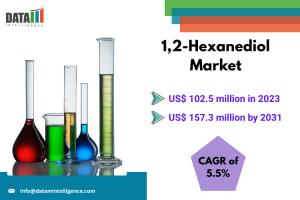1,2-Hexanediol Market Grows with Rising Demand from Cosmetics, Pharma & Industrial Applications | DataM Intelligence
Explore the 1,2-Hexanediol market’s growth in cosmetics, pharma, and industrial uses, driven by sustainability, bio-based production, and regulatory trends.
Download latest sample pdf : https://datamintelligence.com/download-sample/1-2-hexanediol-market
Market Drivers are :
Surge in cosmetics and personal care formulations: Consumers increasingly demand clean‑label, preservative‑effective products, driving formulators to adopt 1,2-Hexanediol.
Stricter regulations on parabens and formaldehyde releasers in North America and Europe are driving demand for alternative preservatives with strong antimicrobial performance.
Growth in pharmaceutical excipients: Its low irritation profile and solvent properties support emerging drug delivery systems and topical formulations.
Expansion of industrial lubricant and metalworking fluids: 1,2-Hexanediol enhances corrosion protection and fluid stability, meeting rising performance standards.
Growing demand in household and institutional cleaners is driven by antimicrobial benefits that enhance the shelf life of eco-friendly disinfectants and surface cleaners.
Technological advancements in biotechnology: Novel bio‑based production routes using fermentation are improving sustainability credentials and cost structures.
Growth of e‑commerce and personalized beauty: Small‑batch, custom formulations leverage versatile solvents like 1,2-Hexanediol for rapid product development.
Key Players are :
Major companies shaping the 1,2-Hexanediol market include:
BASF SE
Solvay
Celanese Corporation
Eastman Chemical Company
Hefei TNJ Chemical Industry Co., Ltd.
CHUNGDO FINE CHEMICAL CO., LTD.
Sabinsa Corporation
Kowa Europe
Knowde
Saiper Chemicals Pvt Ltd
These players compete through innovation in manufacturing processes, expansion of production capacity, and partnerships with downstream formulators to develop tailored solutions.
Market Segmentation
By Grade
Cosmetic/Pharmaceutical Grade: High-purity diol used in skincare, makeup, and drug formulations.
Industrial Grade: Technical-grade 1,2-Hexanediol for lubricants, cleaners, and corrosion inhibitors.
By Application
Cosmetics & Personal Care: Emollients, humectants, preservatives in creams, serums, and cleansers.
Pharmaceuticals: Solvents and stabilizers in topical and inhalation products.
Industrial Lubricants & Metalworking Fluids: Additives for anti‑wear and anti‑corrosion performance.
Household & Institutional Cleaners: Preservatives and solubilizers in eco‑friendly disinfectants.
Agrochemicals: Carriers and stabilizers in pesticide formulations.
Others: Textile processing, adhesives, and sealants.
By Region
North America: Largest share, driven by strong cosmetics and pharma sectors.
Europe: Rapid adoption due to stringent cosmetic regulations and green chemistry initiatives.
Asia‑Pacific: Fastest growth, with expanding personal care markets in China, India, and Southeast Asia.
Latin America: Emerging demand tied to growing beauty and industrial sectors.
Middle East & Africa: Niche growth in premium cosmetics and specialty industrial uses.
Latest News – USA
In mid-2024, Eastman Chemical Company announced the commissioning of a new continuous-flow reactor at its Tennessee facility, doubling U.S. capacity for 1,2-Hexanediol and reducing energy consumption by 15%. Simultaneously, Celanese Corporation launched a collaborative innovation program with leading personal care brands in California to develop next‑generation preservative blends based on 1,2-Hexanediol for natural and vegan formulations.
Latest News – Japan
In early 2024, Solvay partnered with a major Japanese cosmetics firm to trial bio‑sourced 1,2-Hexanediol produced via enzymatic fermentation, aiming to achieve zero‑carbon footprints in premium skincare products. Kowa Europe’s Tokyo subsidiary also reported successful pilot runs of high‑purity diol grades at its Shiga plant, intended for use in advanced pharmaceutical inhalers and high‑end haircare lines.
Key Developments are :
BASF SE has expanded its German production network with a new downstream distillation column, boosting the purity of cosmetic-grade 1,2-Hexanediol to 99.9%.
Hefei TNJ Chemical introduced a new membrane‑based purification technology that cuts water usage by 30% in its China-based diol plant.
Sabinsa Corporation received NSF/ANSI 305 certification for its organic 1,2-Hexanediol, expanding its potential use in certified natural cosmetic products.
CHUNGDO FINE CHEMICAL unveiled a pilot project for integrated carbon capture in its South Korean facility, aiming to reduce CO₂ emissions per ton of diol by 25%.
Knowde launched an online formulation platform, enabling brand owners to source and test technical data sheets for multiple grades of 1,2-Hexanediol in real time.
These milestones highlight the industry’s focus on sustainability, advanced purification, and digital tools to accelerate product innovation.
Conclusion :
With rising demand for safer, multifunctional ingredients, the 1,2-Hexanediol market is set to grow at a 5.5% CAGR through 2031.Its unique combination of solvent power, antimicrobial efficacy, and low toxicity underpins a wide spectrum of applications from green cosmetics to high-performance lubricants. Ongoing improvements in bio‑based production, energy‑efficient manufacturing, and strategic partnerships will further bolster market growth. Ultimately, 1,2-Hexanediol stands at the nexus of performance and sustainability, driving next‑generation formulations that meet evolving regulatory and consumer demands.
Purchase Your Subscription to Power Your Strategy with Precision: https://www.datamintelligence.com/reports-subscription
Browse for more related reports :
1,4 Butanediol (BDO) Market
Cosmetic Pigments and Dyes Market
Sai Kumar
DataM Intelligence 4market Research LLP
+1 877-441-4866
email us here
Visit us on social media:
LinkedIn
X
Legal Disclaimer:
EIN Presswire provides this news content "as is" without warranty of any kind. We do not accept any responsibility or liability for the accuracy, content, images, videos, licenses, completeness, legality, or reliability of the information contained in this article. If you have any complaints or copyright issues related to this article, kindly contact the author above.
Hannox Launches Advanced Hydrogel Dressing for Safer, Faster Wound Healing
Bidding Set to Close on 4BR/2BA Home on 3.8± Acres in Spotsylvania County VA Announces Nicholls Auction Marketing Group
IoT Microcontroller Market to Rise at CAGR of 14.2% to Reach US$ 27,405 Million by 2035: Fact.MR Study
Więcej ważnych informacji
 Jedynka Newserii
Jedynka Newserii

 Jedynka Newserii
Jedynka Newserii

Polityka

Unijne mechanizmy ułatwiają zwiększenie wydatków na obronność przez europejskie kraje NATO. Ważnym aspektem infrastruktura podwójnego zastosowania
Wydatki na obronność w krajach NATO mają wzrosnąć do 2035 roku do 5 proc. PKB. W dużej mierze będzie to możliwe dzięki Unii Europejskiej, która stworzyła ramy umożliwiające krajom członkowskim realizację celów NATO w zakresie obronności, nie tylko poprzez finansowanie i inwestycje, ale także poprzez elastyczność budżetową. – To pełna synergia, można powiedzieć, że Unia Europejska współfinansuje razem z państwami członkowskimi cele zdolnościowe NATO – ocenia Paweł Zalewski, sekretarz stanu w Ministerstwie Obrony Narodowej.
Ochrona środowiska
Rusza budowa lądowej infrastruktury dla projektów Bałtyk 2 i Bałtyk 3. Prąd z tych farm wiatrowych popłynie w 2027 roku

Ruszyła budowa lądowej infrastruktury dla morskich farm wiatrowych Bałtyk 2 i Bałtyk 3 rozwijanych przez Equinor i Grupę Polenergia. To przede wszystkim baza serwisowa w Łebie i dwie stacje elektroenergetyczne. Jednocześnie trwają przygotowania do rozpoczęcia prac na morzu. Pierwszy prąd z obu projektów popłynie w 2027 roku, a w kolejce czeka morska farma wiatrowa Bałtyk 1 – największy i najbardziej zaawansowany projekt II fazy rozwoju offshore.
Edukacja
Uczelnie zaczynają wspólnie walczyć ze zjawiskiem mobbingu i dyskryminacji. Ruszają badania nad skalą problemu

Szkoły wyższe chcą aktywniej walczyć ze zjawiskiem mobbingu i dyskryminacji zarówno wobec pracowników, jak i studentów. W ramach projektu Bezpieczna Uczelnia będą się wymieniać dobrymi praktykami w zakresie polityki antymobbingowej. Zostaną przeprowadzone także badania na temat obecnej sytuacji w środowisku akademickim. Dotychczasowe badania prowadzone przez Fundację Science Watch Polska wskazują, że mobbing to dość powszechne zjawisko na uczelniach, które przybiera charakterystyczne dla środowiska formy.
Partner serwisu
Szkolenia

Akademia Newserii
Akademia Newserii to projekt, w ramach którego najlepsi polscy dziennikarze biznesowi, giełdowi oraz lifestylowi, a także szkoleniowcy z wieloletnim doświadczeniem dzielą się swoją wiedzą nt. pracy z mediami.








.gif)

 |
| |
| |
|